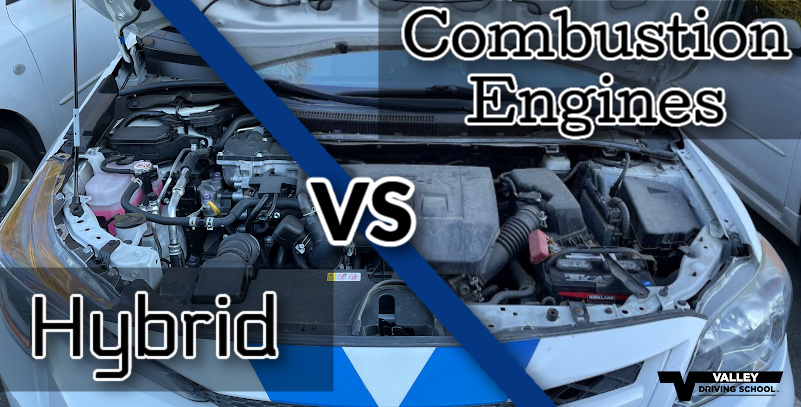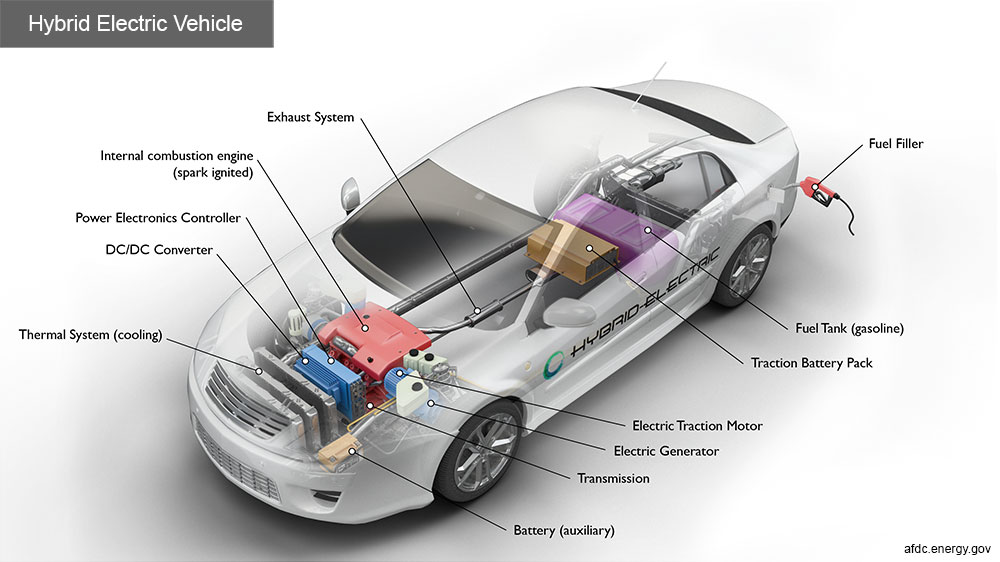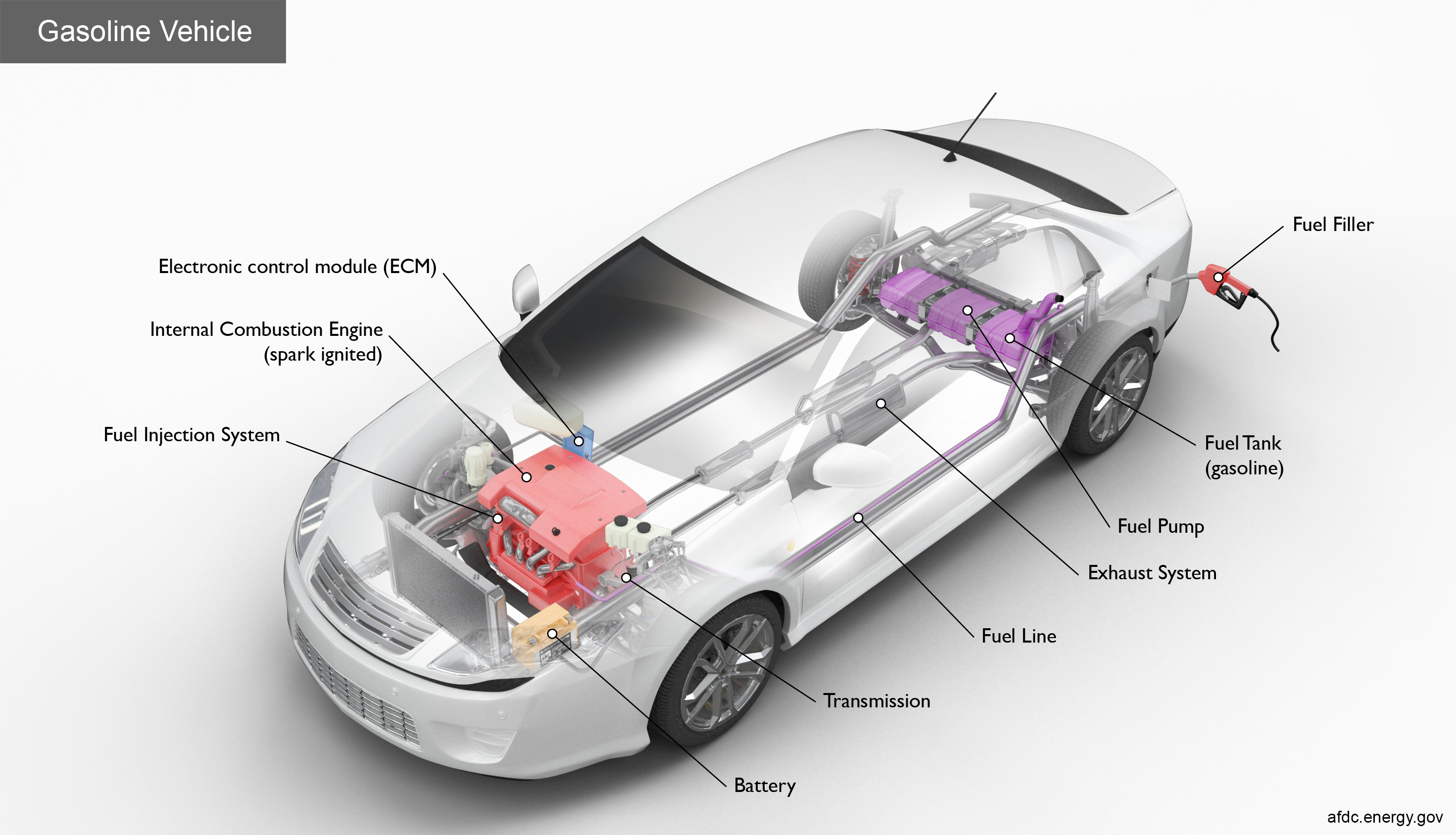Hybrid vehicle technology has grown by leaps and bounds over the past few years thanks in part to highly sensationalized media portrayals and global environmental crises surrounding the oil and gas sectors. Consumers looking to make a positive and eco-friendly impact on the sustainability of environmentally friendly technologies now have different options when purchasing a new vehicle.
Hybrids are, in essence, an efficient combination of both electric and gas-powered engines that work together to achieve maximum efficiency and performance. There’s also great potential for tax incentives when purchasing a hybrid over a traditional internal combustion engine.
In this post, we’ll outline some major differences and pros and cons to both hybrid and traditional engine types so you can make an educated decision the next time you’re faced with a tough choice on the showroom floor.

Hybrid Car Engines
Hybrid vehicles have become the new trend for environmentally conscious consumers and they’re also some of the most innovative and refreshing automobile advancements available. A hybrid motor works by harnessing the efficiency of an electric motor and stored battery packs, coupled with the reliability and fuel range of a smaller traditional gasoline engine.
Electric motors use no power at idle, something gasoline engines fail at miserably, yet electric motors have failed to reach the range reliably achieved by gasoline engines - so the hybrid motor works by utilizing electric power during start-and-stop inner city driving, and smaller, sometimes turbocharged gasoline engines for higher speeds and highway driving to maximize efficiency.
What Are The Benefits Of Hybrid Cars?
The benefits of a hybrid engine are vast. From increased efficiency and a reduced bill at the pumps, to eliminating smog pollution levels while at slow speeds in cities and towns. Hybrid drivers are also lucky to avoid the annoyance that many electric vehicle (EV) drivers experience when finding themselves stranded with no charging station for miles around. Hybrid drivers can rely on the gasoline engine - and even regenerative braking technologies in some models - to assist in charging their battery power supply as they drive at speed or slow down.
Gas savings are a monumental selling point for hybrids. A US Department of Transportation study found that by averaging fuel savings, the average driver who covers 24,608 km per year will save about 825 litres of fuel annually. At, say, a fuel cost of $1.14/L that equates to an annual fuel savings of approximately $940.00
Tax incentives are another benefit to purchasing and driving a hybrid vehicle. CBC News reported a new rebate of up to $6,000 was available to BC drivers until March 2018, who opt for a hybrid or a vehicle that features plug-in hybrid technology, a hydrogen fuel cell, or fully-fledged battery electric vehicles.
Drawbacks
The grass isn’t always greener on the other side, however. Hybrid vehicles and their electric counterparts are notoriously expensive when compared to their outdated gasoline burning brethren. Home Guides reports when considering a vehicle with a price tag of $38,375 and cross-comparing it to its own hybrid option, the hybrid costs an approximate $5,560 more, coming in just shy of $44,000. That kick to the wallet essentially renders any BC government rebate null and void of any considerable savings.
Additional and complex parts can also mean additional mechanical problems. Bright Hub Engineering estimates about 92% of electric motor failures occur during startup caused by low resistance. There’s also been reported issues with weak 12V batteries in hybrids like the popular Toyota Prius, meaning that leaving a light on overnight could result in needing a boost in the morning. Conventional battery draining continues to be an issue for many hybrid models, with aftermarket battery replacements costing owners hundreds of dollars to swap out.
Next up are potential price swings on hybrid models as the cost of gasoline perpetually increases. Car manufacturers are businesses at the end of the day, and the rising cost of oil will ultimately dictate an inflated price tag for vehicles that help reduce your bill at the pump.

Traditional Engines
The old school gasoline engine is a marvel of engineering, and over the past century has evolved in leaps and bounds. To say the internal combustion engine is the same wasteful, noisy, dirty, oil consuming pollutant it once was is simply not true. Modern engines are quiet, efficient, innovative, and designed to last.
Traditional engines convert gasoline into motion by a process known as internal combustion. This process is completed by small, controlled explosions within the engine block, used to generate the power required to move the car. These small explosions are held within small, controlled spaces - like below a piston. The energy is expelled through rapidly expanding gas hundreds of times per minute, forcing the pistons to move. When the energy from one explosion is about to run out, another occurs, perpetually maintaining motion within the engine.
Modern vehicle engines operate on a four-cycle combustion cycle including intake, compression, combustion, and exhaust. This cycle combines air, gasoline, and heat in an optimal formula designed to generate a precise amount of power delivered by the gasoline that allows a spark to ignite the fuel.
What Are The Benefits Of Traditional Combustion Engines?
One of the biggest benefits most drivers can agree on, is the power delivery generated in a traditional engine. Hybrids are commonly coupled to small gasoline engines, meaning that awe-inspiring performance is usually missing. The gasoline engine is synonymous with power and torque that’s proving difficult for most consumer hybrid models to match.
There’s also the benefit of existing infrastructure in today’s world. Like electric vehicles and hybrids require charging stations, gasoline powered vehicles require gas stations - which are in abundance. Gasoline is widely available (for now), taking the guesswork out of having to rely on a charging station that may or may not exist near your intended destination.
Third, vehicles powered by traditional gasoline engines are by far the cheaper option for consumers. The market is still populated with a majority of models that come standard with traditional gasoline engines optimized for efficiency.
Drawbacks
Climate change. Depleting oil-based resources. Heightened levels of smog and other pollutants in cities. Traditional engines are without a doubt, one of the largest contributors to increased global temperatures and environmental crisis on the planet.
As a stable fuel source, oil is the result of millions of years of tiny plant and animal life forms dying, mixed with planetary heat and pressure to fossilize and transform organic material into crude oil. Its' existence, therefore, will at some point be depleted to the point where oil is no longer a reliably voluminous source of energy for traditional engines and the heartbeat of the mechanized world. Simply put: it’s going to run out eventually.
The constantly increasing consumption of oil also earmarks our oil-hungry society for increasing oil prices as supplies dwindle into the future. This inevitably means that alternative energy sources will someday win over oil and gasoline - and therefore the traditional internal combustion engine - laying the groundwork to outpace and replace these old style reliable engines.

Are There Benefits to Driving Hybrids and EV’s in British Columbia?
British Columbia is known throughout Canada and the world as environmentally conscious, thanks to our vast outdoor spaces, bountiful wildlife, forests, and waterways, and an active culture that supports health and outdoor lifestyles. Our geography and provincial culture, therefore, seem to make hybrid and electric vehicles a natural choice for some BC drivers. The provincial government seems to agree with that statement.
The BC SCRAP-IT Program gives up to $6,000 towards the purchase or lease of a new electric vehicle (EV), and $3,000 towards a used EV when you scrap your previously owned traditional gasoline powered vehicle. Their incentives don’t stop there, either. People who opt into the program may also select an 11-month BC Transit Ecopass, mobility scooters, electric bikes, car share credits, or cash.
The provincial government also maintains a hybrid and/or EV rebate available to those planning to purchase a zero-emission vehicle. Incentives vary depending on what type of hybrid, plug-in, or EV you purchase, but are as follows:
- $6,000 for the purchase or lease of a hydrogen fuel-cell vehicle
- $5,000 for the purchase or lease of a new battery electric vehicle
- $2,500 – $5,000 for the purchase or lease of a plug-in hybrid electric vehicle
Vehicles with a retail price of over $77,000 aren’t eligible for the rebate program, so that new Tesla Model S may have to wait. Coupled with the SCRAP-IT program incentive, the BC rebate could spell a price reduction of up to $12,000.
Driving is a luxury that we have to earn in order to enjoy. What we sometimes forget, is that driving somewhere for a holiday, or a leisurely Sunday cruise with family or friends won’t mean much if we continually degrade and neglect our natural spaces and the health of the planet.
Resource extraction and the burning of fossil fuels in our traditional internal combustion engines is a huge contributing factor to many of the issues our planet faces, so making the shift to hybrid, fuel cell, EV, or plug-in hybrid technology may be a great place to begin respecting the planet, reducing our reliance on gasoline, and saving the place we call home.
